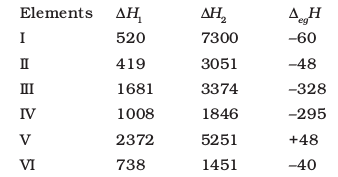3.31 The first (∆iH1) and the second (∆iH2) ionization enthalpies (in kJ mol–1) and the (∆egH) electron gain enthalpy (in kJ mol–1) of a few elements are given below:

Which of the above elements is likely to be :
(a) the least reactive element.
(b) the most reactive metal.
(c) the most reactive non-metal.
(d) the least reactive non-metal.
(e) the metal which can form a stable binary halide of the formula MX2(X=halogen).
(f) the metal which can form a predominantly stable covalent halide of the formula MX (X=halogen)?
NEETprep Answer3.32 Predict the formulas of the stable binary compounds that would be formed by the combination of the following pairs of elements.
(a) Lithium and oxygen
(b) Magnesium and nitrogen
(c) Aluminium and iodine
(d) Silicon and oxygen
(e) Phosphorus and fluorine
(f) Element 71 and fluorine
NEETprep Answer3.33 In the modern periodic table, the period indicates the value of :
(a) atomic number
(b) atomic mass
(c) principal quantum number
(d) azimuthal quantum number.
NEETprep Answer3.34 Which of the following statements related to the modern periodic table is incorrect?
(a) The p-block has 6 columns, because a maximum of 6 electrons can occupy all the orbitals in a p-shell.
(b) The d-block has 8 columns, because a maximum of 8 electrons can occupy all the orbitals in a d-subshell.
(c) Each block contains a number of columns equal to the number of electrons that can occupy that subshell.
(d) The block indicates value of azimuthal quantum number (l) for the last subshell that received electrons in building up the electronic configuration.
NEETprep Answer3.35 Anything that influences the valence electrons will affect the chemistry of the element. Which one of the following factors does not affect the valence shell?
(a) Valence principal quantum number (n)
(b) Nuclear charge (Z)
(c) Nuclear mass
(d) Number of core electrons.
NEETprep Answer3.36 The size of isoelectronic species — F–, Ne and Na+ is affected by
(a) nuclear charge (Z)
(b) valence principal quantum number (n)
(c) electron-electron interaction in the outer orbitals
(d) none of the factors because their size is the same.
NEETprep Answer3.37 Which one of the following statements is incorrect in relation to ionization enthalpy?
(a) Ionization enthalpy increases for each successive electron.
(b) The greatest increase in ionization enthalpy is experienced on removal of electron from core noble gas configuration.
(c) End of valence electrons is marked by a big jump in ionization enthalpy.
(d) Removal of electron from orbitals bearing lower n value is easier than from orbital having higher n value.
NEETprep Answer3.38 Considering the elements B, Al, Mg, and K, the correct order of their metallic character is :
(a) B > Al > Mg > K
(b) Al > Mg > B > K
(c) Mg > Al > K > B
(d) K > Mg > Al > B
NEETprep Answer3.39 Considering the elements B, C, N, F, and Si, the correct order of their non-metallic character is :
(a) B > C > Si > N > F
(b) Si > C > B > N > F
(c) F > N > C > B > Si
(d) F > N > C > Si > B
NEETprep Answer3.40 Considering the elements F, Cl, O and N, the correct order of their chemical reactivity in terms of oxidizing property is :
(a) F > Cl > O > N
(b) F > O > Cl > N
(c) Cl > F > O > N
(d) O > F > N > Cl